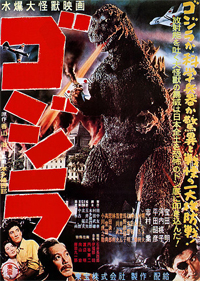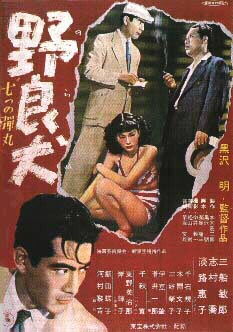 Godzilla
Godzilla
![]()
![]()
![]()
![]()
![]()
Directed by Ishiro Honda.
Starring Akira Takarada, Momoko Kochi, Akihiko Hirata, Takashi Shimura and Fuyuki Murakami.
Stray Dog
![]()
![]()
![]()
![]()
![]()
Directed by Akira Kurosawa.
Starring Toshiro Mifune, Takashi Shimura, Keiko Awaji and Eiko Miyoshi.
Although Godzilla creator and producer Tomoyuki Tanaka lifted monster-sized elements from King Kong (1933) and The Beast from 20,000 Fathoms (1953), an early film featuring effects by Ray Harryhausen (Clash of the Titans), the immediate inspiration for Godzilla was a 1954 incident in which a fishing boat called the Lucky Dragon was scorched by an American H-bomb test, seriously burning several of the crew and causing the eventual death of its radio operator from radiation poisoning — clearly the reference point for the opening scene of the original 1954 Japanese Godzilla in which Godzilla’s attack on a small boat appears only as a flash of light.
Science fiction writer Shigeru Kayama, along with screenwriters Ishiro Honda (who also directed) and Takeo Murata, extended the metaphor a bit by paralleling many scenes of death and destruction in Godzilla’s wake with the aftermath of the H-bomb attacks on Hiroshima and Nagasaki, using images of a flattened, burning town and hospitals overflowing with people. These images vividly recall what little documentary footage I’ve seen of the Hiroshima aftermath (to be specifc, the stock footage used in the first 20 minutes of Alain Resnais’ Hiroshima Mon Amour), but pretending that the film’s deeper meaning is much more complicated than “H-bomb testing is bad” is giving the filmmakers a little more credit than they deserve.
Excised from the 1956 Americanized version of the film — which removed, in all, 40 minutes of footage and added in several awkward scenes with Raymond Burr (written and directed by an American crew) — these restored scenes only lift Godzilla up from simply being a fun, cheesy giant monster movie to being a really good, fun, cheesy giant monster movie.
Many of Godzilla’s special effects are surprisingly good for the time and Akira Ikufube’s somber score adds to the feeling of impending doom, but the trouble is that when doom finally arrives, it’s really just not all that scary or exciting (whichever it’s trying to be). Many sequences in Godzilla are undeniably great — restored to its full 13 minutes, Godzilla’s second rampage is delightful, partly because of and partly in spite of a few giggle-inducing moments which I think were supposed to be frightening — but the film isn’t a gripping, tautly structured allegorical masterpiece by any stretch of the imagination. Ultimately, 50 years later, this first Godzilla is more interesting as a historical artifact from postwar Japan, shortly after the American occupation ended, than as a piece of entertainment.
 Those familiar with the films of Akira Kurosawa will immediately recognize Takashi Shimura (Ikiru, The Seven Samurai) in the cast of Godzilla, though he is pretty much wasted in his role as the grandfather of all “we should study the thing that just killed hundreds of people!” scientists, Dr. Yamane. (He would reprise this role in 1959’s Godzilla Raids Again.)Shimura appeared in over a dozen Kurosawa films, from 1943’s Judo Saga, Kurosawa’s first film as director, to the actor’s last film, 1980’s Kagemusha: the Shadow Warrior, most often supporting Kurosawa’s favorite leading man, Toshiro Mifune, as in Stray Dog (1949), recently released for the first time on DVD by the Criterion Collection.
Those familiar with the films of Akira Kurosawa will immediately recognize Takashi Shimura (Ikiru, The Seven Samurai) in the cast of Godzilla, though he is pretty much wasted in his role as the grandfather of all “we should study the thing that just killed hundreds of people!” scientists, Dr. Yamane. (He would reprise this role in 1959’s Godzilla Raids Again.)Shimura appeared in over a dozen Kurosawa films, from 1943’s Judo Saga, Kurosawa’s first film as director, to the actor’s last film, 1980’s Kagemusha: the Shadow Warrior, most often supporting Kurosawa’s favorite leading man, Toshiro Mifune, as in Stray Dog (1949), recently released for the first time on DVD by the Criterion Collection.
(Incidentally, Shimura isn’t Godzilla’s only link to Stray Dog. Godzilla director Ishiro Honda also served as Kurosawa’s chief assistant director on the earlier film. Later on in their careers, the two would pair up again, with Honda serving as assistant or second unit director on all five of Kurosawa’s last films: Kagemusha, Ran, Dreams, Rhapsody in August and, finally, the heartbreakingly appropriate masterwork Madadayo [Not Yet], which was both Honda and Kurosawa’s last film before their deaths in 1993 and 1998, respectively.)
While not Kurosawa’s first foray into film noir (that distinction belongs to Drunken Angel, which also featured Shimura and Mifune, in his first Kurosawa role), Stray Dog is widely acknowledged one of Kurosawa’s earliest masterpieces. Strongly influenced in its tone by American film noir, particularly Jules Dassin’s The Naked City (1948), Stray Dog is something like the Pulp Fiction of Japanese film noir (whereas Drunken Angel would be its Reservoir Dogs), influencing filmmakers such as Takeshi Kitano (Boiling Point), Shohei Imamura (Endless Desire) and Seijun Suzuki (Branded to Kill).
Set during the American occupation of Japan, Stray Dog centers on a young detective (Mifune, in his third of 16 Kurosawa roles) whose gun is stolen from him on a crowded train and the his increasingly frantic efforts to retrieve it. Takashi Shimura co-stars as the older and wiser partner, Detective Sato, whose purpose is served mainly by one somewhat didactic scene near the middle where Sato espouses much of the film’s themes. With the arguable exception of one too-long sequence towards the beginning of just a few too many shots of Mifune’s Detective Murakami wandering (undercover) the streets looking for black market gun dealers, Stray Dog is relentlessly paced from the start of the film to Murakami’s desperate face-off with the titular character; it’s a hell of a movie that no Kurosawa fan or crime film lover should miss.
Accompanying a new high definition digital transfer of the film is a fascinating, if overly talkative, commentary track by Stephen Prince, author of The Warrior’s Camera: The Cinema of Akira Kurosawa, which provides a great deal of historical context and is well worth checking out, as is the 32-minute documentary (an excerpt from a Japanese TV program called “Akira Kurosawa: It Is Wonderful to Create”) on the making of the film.
Godzilla is playing at the Music Box through July 15. I think Toshiro Mifune could take the big G in a fight.
The Criterion Collection’s edition of Stray Dog is available through Netflix, GreenCine.com, and (good) video stores everywhere.
(Originally published at Gapers Block on July 9, 2004.)
